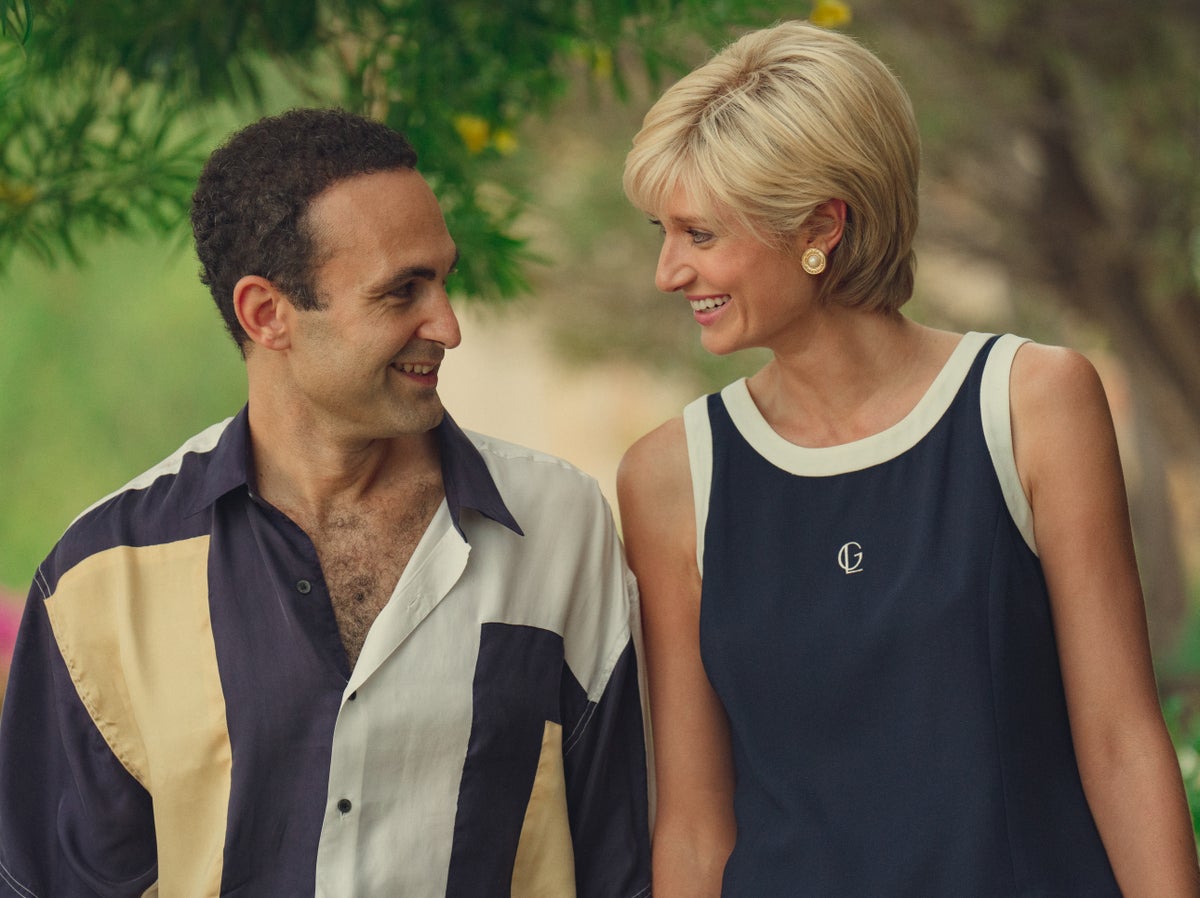
Death and taxes: life’s two great certainties. Well, if you’re the royal family you don’t have to worry much about the latter, but the former comes for them, just as for us mere mortals. And death hangs over this, the first instalment of Netflix’s two-part final season of The Crown. Whether it’s a paparazzi-hounded Mercedes-Benz streaking through the sultry Paris night, or three generations of monarchs (and future monarchs) standing side by side, united in grief, death makes us all human.
This four-episode arc charts the romance of Princess Diana (Elizabeth Debicki) and Dodi Fayed (Khalid Abdalla) in the days and weeks running up to their deaths in the Pont de l’Alma tunnel. You might call it a “slow-motion car crash” except that the moment of impact plays out, just offscreen, twice: firstly, through the eyes of a French moonlit dog walker, and then, again, in the backseat with Di and Dodi. It is the moment the show has been moving, inexorably, towards, and one that plays out while Charles (Dominic West), his parents (Imelda Staunton and Jonathan Pryce) and his young children, stand idle, then dumbstruck, in Balmoral.
If the past is a foreign country, as LP Hartley wrote, then the recent past is a much less foreign country. With Tony Blair in Downing Street, George Michael on the radio, and the young princes gabbing about Bond girls, the gulf between history and the present day has never felt more bridgeable. But it has also never felt more like tittle-tattle (“One would almost feel sorry for her,” the Queen announces, “if one weren’t so cross with her”). Indeed, even the show’s signature theme music – a soaring string arrangement by Hans Zimmer, that felt so right as it ferried viewers through the post-war period – feels out of place when sandwiched between million-pound paparazzi photos being sold to the Daily Mirror, and shots of Camilla Parker Bowles blowing out the candles on an enormous birthday cake.
While Diana is given a saintlike aura through Debicki’s well-honed performance, Dodi is, if not quite played for laughs, portrayed as a bland, nouveau riche man-child, trapped between his puppeteer father, Mou Mou, and the object of his, undoubted, affection. It is a process of humanisation not extended to Henri Paul, the driver who lost his life in the crash, or Dodi’s bodyguard Trevor Rees-Jones, who was seriously injured. But the show routinely privileges gossip over emotional resonance: highly speculative conversations between Diana and Dodi are included – and drive the plot – whereas Charles breaks the news of Diana’s death to the prince, in a scene we, the audience, are not permitted to overhear. This tabloid tone relegates Staunton’s Queen to a side character, while Lesley Manville’s Princess Margaret slips by entirely unnoticed.
The whole sequence of episodes give a sense of the show’s creator, Peter Morgan, catching up with his roots. After all, it was his screenplay for the 2006 movie The Queen that sparked this new career as a royal Kremlinologist. That film trod the same ground as the series’ fourth episode, “Aftermath”, and shares some of the symbolism. In The Queen, a stag on the Balmoral estate, spared by a merciful Helen Mirren, comes to represent the dwindling power of the monarchy; in this iteration, the creature – shot by Prince William (played, in convincing teen heartthrob mode, by newcomer Ed McVey) in his first “blooding” – signifies a loss of innocence. The most obvious diversion from the previously trodden path is the parallel drawn between the tactile, available grief of Mohamed Al-Fayed (Salim Daw) and the icy reserve of the Windsors. “I am their brother in sorrow,” Al-Fayed declares, but if there is fraternal feeling it is more of the smashed-on-a-dog-bowl variety. Instead, Charles’s mercurial affections are exposed via the medium (no pun intended) of a post-mortem private jet powwow with his deceased ex-wife (Mou Mou is offered the same construct, with a suddenly sagacious Dodi). It is a device of incredible convenience, where subtlety would’ve been a more interesting choice.
But The Crown has always peddled in easy answers. Big, brassy metaphors for the decline of empire; foreshadowings of tragedy or triumph. This is no different. “There are worse places to be trapped than a jewellery shop,” Dodi tells Diana, on a rough night out in Monte Carlo, offering a new twist on the tired “gilded cage” metaphor. And when Diana laments her wish to move away and “start afresh”, Dodi asks her, “California?” “Exactly,” she replies, with the unavoidable flicker of Harry and Meghan in her eyes. Even a Scottish portrait photographer solemnly announcing, of the Queen, that “we’ll miss her terribly when she’s gone”, is fraught, now, with consequence. The show’s dialogue, which, in its portentous tone has often flirted with hamminess, now feels tailored to the cynical purpose of gravitas.
While the shadow of death can offer creative tension, it also makes The Crown feel like an ailing project. “You’ve taught us what it means to be British,” the ghost of Princess Diana tells the Queen (yes, you read that correctly). And The Crown, similarly, has taught the world what it meant to be British, in the 20th century. But it has also run out of road – run out of history to retread – and, on its last legs, has less to say than ever, about what it means to be British now.







